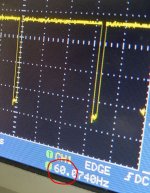Question for all, but clearly daver2 is the man that will know since this is his baby. 
I downloaded PETTESTER V04 from this post .
Trying it in a 8032 (50Hz, Business keyboard), gives me intermittent, and non-repeatable, results. I've seen it load and run on a 50Hz system, more often that not, it ran at 60Hz, causing V-sync issues and - often - I just get a blank screen.
My Googling skills are failing me and I cannot find a site where the PETTESTER is hosted.
Basically looking for the latest and greatest version that will run on a 50Hz, Business 8032.
Thanks!
I downloaded PETTESTER V04 from this post .
Trying it in a 8032 (50Hz, Business keyboard), gives me intermittent, and non-repeatable, results. I've seen it load and run on a 50Hz system, more often that not, it ran at 60Hz, causing V-sync issues and - often - I just get a blank screen.
My Googling skills are failing me and I cannot find a site where the PETTESTER is hosted.
Basically looking for the latest and greatest version that will run on a 50Hz, Business 8032.
Thanks!




